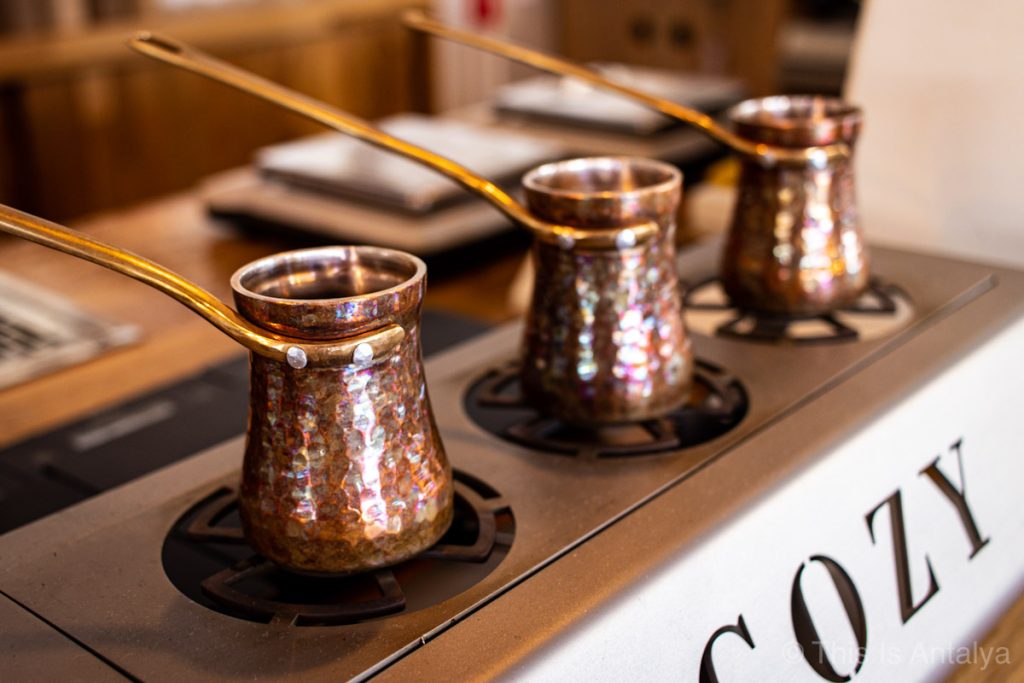Regardless of your stance on coffee, you shouldn’t leave Turkey without at least trying an ornate little cup of traditional Türk Kahvesi (Turkish coffee). This unique experience can be a bit intimidating to undertake but is easily enhanced with a little bit of background information. Turkish coffee is not so much a type of coffee as it is a way of preparation. Often the beans are sourced from Brazil and lightly roasted, but recently, more creative experimentation is occurring and creating a variety. You could define something as Turkish coffee if the beans have been ground into a very fine powder and then brewed in what is called a cezve over a small flame. The beauty of the tradition of Turkish coffee means you can find a good cup nearly anywhere – at cafes, specialty coffee shops or restaurants.
How do I order it? First, there is a little bit of customization. Because the brewing and serving method does not allow sugar to be added after your coffee is prepared you need to make the decision when you order. Generally, your options are Şekerli (sugary) pronounced sheck-air-lee, Orta (semi-sugary) pronounced or-tah, or Sade (plain) pronounced sah-day. On average, it would be roughly two teaspoons of sugar for sugary and one for semi-sugary. If this is your first attempt at Turkish coffee, ordering it şekerli will probably put it more in a dessert category as the flavor will not resemble any coffee you have tasted before.
What do I expect? Presentation of Turkish coffee rivals its brewing in distinctiveness and ritual. Some cafés serve it in ornate, Ottoman style silver serving dishes; and each cup, no matter the appearance, comes with a little treat with your cup and a small glass of water. Why the water? There are a few explanations for this: to cleanse your palate before and after, to satiate your thirst to ensure you slowly sip your coffee or my favorite, to rinse your teeth from any stray coffee grounds. Delights such as lokum (Turkish delight), chocolate or a cookie ensure Turkish coffee fans enjoy all the flavors.
How do I drink it? When your tray arrives, don’t immediately take a sip. It will most likely have just been poured into the cup so the grounds may not have settled fully. After a minute, slowly begin sipping, carefully drinking the coffee gradually because the bottom third of your cup will basically be coffee mud. No matter what anyone tells you, DO NOT DRINK this.
Are there options? A few cafes feature a broader Turkish Coffee menu. Places like Bayramefendi Osmanlı, Turk Kahvesi and Yemen Kahvesi offer not only the traditional but also flavored options like banana, watermelon, chocolate or hazelnut. You can order sütlü (with milk), for milk to be added before the brewing process. My favorite is a unique coffee called menengiç, which isn’t made from coffee beans but a finely ground wild pistachio.
Afiyet olsun! Enjoy your Turkish coffee!!



1 Comment. Leave new
[…] The sound of spoons clinking on glass and the buzz of conversation and laughter. A walk down a Turkish street leads you to the source-a café. Café culture here has existed for centuries and continues to be one of the preferred pastimes of people. In stark contrast to Italian espresso bars and American Starbucks, this is not a quick stop to refuel, but a place to linger. Time takes a back seat to relationships, best developed over cups of çay (tea) or kahve (coffee). While you are here, trying Turkish coffee is so highly recommended that we wrote an entire post about it. […]